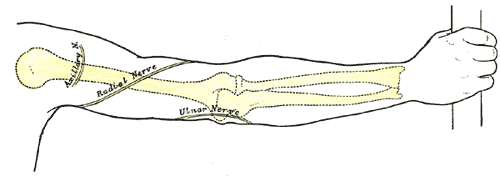What exactly are the best tennis elbow stretches and what are “eccentric stretches? I played softball in an adult league for the first time this past spring. At 26, I was the youngest guy on my team, but it had been nearly 10 years since I’d played organized baseball back in high school. I still had it though. My arm is strong – very strong. I threw one batter out at the plate from center and nearly got two more, all with a softball! So you could imagine the shock of all the 40-somethings when I turned up as the injured player. Every game I had to complain about throbbing pain in my right bicep, tricep and elbow. What was happening? Tennis elbow is one of the most notorious repetitive strain injuries.
My physical therapist (and I thought I was too young to have a personal one) said it was easily diagnosed as a case of tennis elbow. Tennis elbow? This is softball! Doesn’t matter. Tennis elbow is a condition defined by (intense) lateral pain on the upper arm by the elbow. Any sport or job that involves a lot of repetitive ‘twisting’ – fix-it guys, plumbers, you name it – sees a lot of tennis elbow problems.
Eccentric Contractions
A 2009 New York Times article pointed to the changing attitude physical therapists have to tendon injuries like tennis elbow. Consider when you do a bicep curl. There, you are making a concentric movement – your bicep tightens as your forearm and upper arm close in on each other. Now think about lowering the weight. That lowering is a prime example of eccentric movement, expanding the muscles involved. Stretch out your arms as straight as possible and curl your wrist back. Hold for 8 to 10 seconds. That should make you feel the stretch in your wrists and your elbows.
“‘You can load a tendon so much more eccentrically’ than with concentric exercises, Dr. Timothy Tyler says. ‘So we think the process may be remodeling the tendon.’ Ultrasound studies by other researchers, including the group in Belgium, have shown that damaged tendons typically become less thick, indicating they are less damaged, after a course of strenuous eccentric exercise.” – New York Times
The techniques Dr. Tyler and his colleagues have been researching is the use of flexible bars as a way to enable resistance on a pushing or pulling arm (for the purposes of tennis elbow stretches, obviously. Check out the video below for a quick demo of the Thera-Band FlexBar that’s been called somewhat of a breakthrough in treating tennis elbow:
There are also a number of other, simpler techniques that give the wrists and elbows relief. This video gives a pretty decent summary and has bonus carpal tunnel stretches! Good luck:




